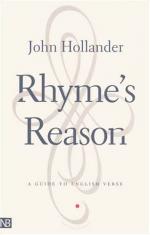|
This section contains 389 words (approx. 1 page at 400 words per page) |

|
Ode Forms, Quantitative Verse and Classical Meters and Their Adaptions Summary and Analysis
Before discussing the importance and predominance of repetition as a structure in modern verse, Hollander first looks at the very complex form of the Greek choral ode to provide contrast. Greek poetry used a system of syllable lengths rather than accents. Choral odes were performed during plays or at public events and were sung while the singers also danced. Choral odes are divided into sections called triads, with each triad having three parts. The first part of the triad is called the strophe, which means "turn." The dancers would sing the lines while moving, and stop their movements at the end of the first part. The second part, called the antistrophe, or "counterturn," repeated the same rhythm of syllables and motions as the...
(read more from the Ode Forms, Quantitative Verse and Classical Meters and Their Adaptions Summary)
|
This section contains 389 words (approx. 1 page at 400 words per page) |

|




